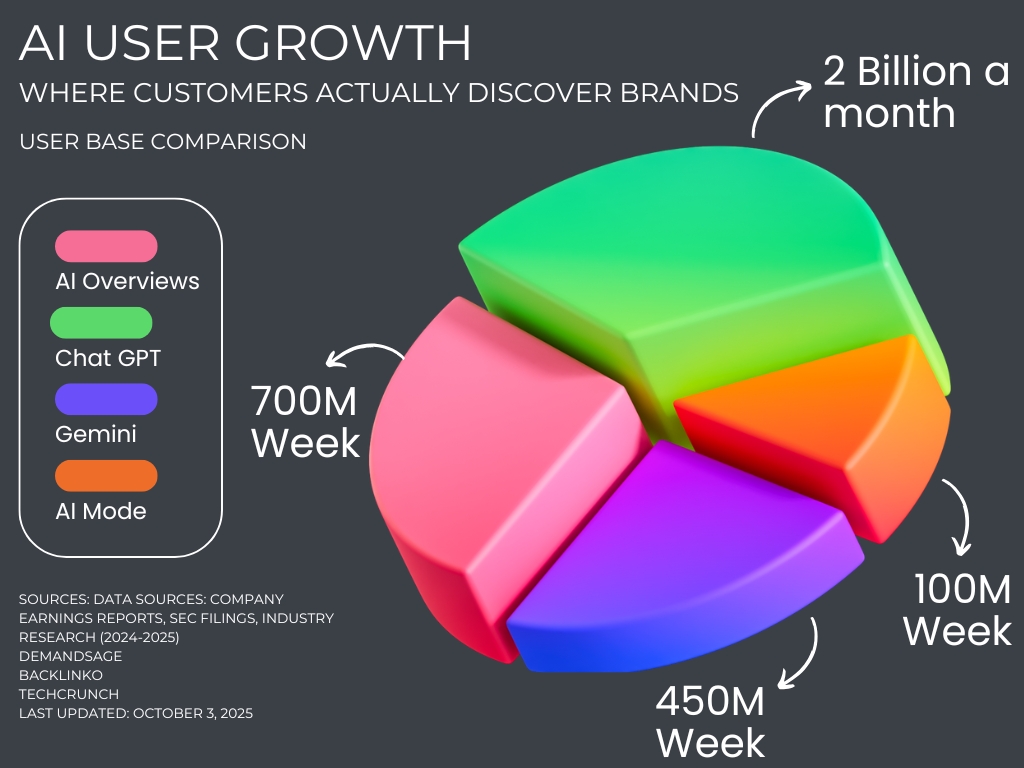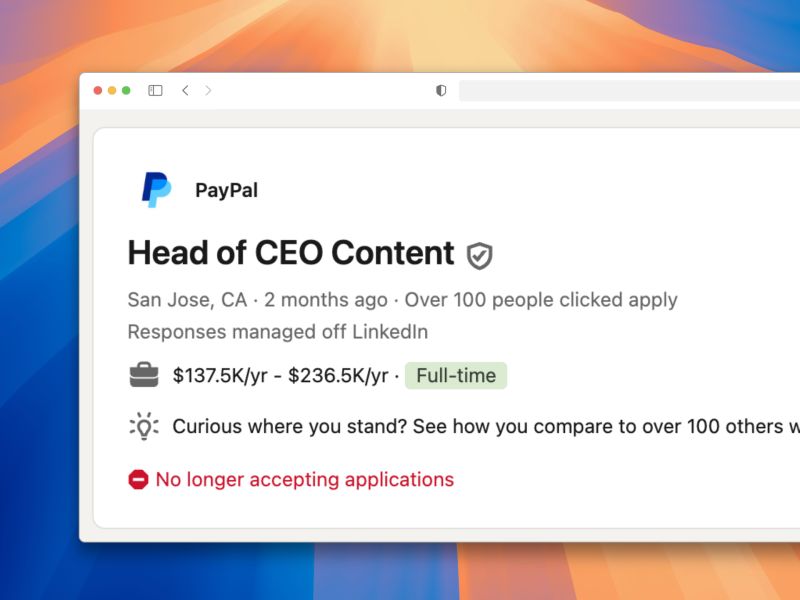BEYOND
RANKINGS
THE FOUR PILLARS OF DIGITAL DOMINANCE
This Article Is Human Authored
By Jeff Payne
Why smart business leaders are shifting from chasing algorithm updates to building unstoppable brand engines
The SEO game has fundamentally changed. While your competitors obsess over the latest Google update, the smartest CEOs are building something more powerful: brand engines that don’t just rank—they dominate conversations, command premium pricing, and create customers who become evangelists.
If you’re still thinking about digital marketing as a technical exercise in keyword density and meta tags, you’re fighting yesterday’s war with yesterday’s weapons.
PILLAR 1: AI AS YOUR
STRATEGIC INTELLIGENCE
SYSTEM
The 5% that drives 95% of your results isn’t hidden in spreadsheets—it’s scattered across the new landscape where your customers actually discover brands: ChatGPT, Gemini, Perplexity, AI Overviews, and AI Mode searches.

The AI Discovery Explosion
The AI discovery landscape has witnessed unprecedented growth in 2025, with platforms racing to capture user attention at an extraordinary pace.
ChatGPT continues to dominate as the clear leader, boasting 700-800 million weekly active users as of August 2025—a remarkable doubling from just 400 million users in February. This explosive growth cements its position as the fastest-growing consumer application in history, maintaining its first-mover advantage in the conversational AI space.
Meanwhile, Google’s AI Overviews has achieved massive reach by embedding directly into search behavior. With 2 billion monthly users as of July 2025 (up from 1.5 billion in May), it touches more users than any standalone AI platform. Available across 200+ countries and territories, AI Overviews is driving over 10% increases in Google Search usage for queries where it appears, fundamentally reshaping how people find information.
Gemini, Google’s dedicated AI assistant, has grown to 450 million monthly active users by mid-2025, climbing from 400 million just two months prior. Its 35 million daily active users represent nearly 4x growth since October 2024, demonstrating strong momentum as Google integrates AI across its entire ecosystem.
For power users seeking even deeper capabilities, Google introduced AI Mode—the most advanced AI search experience powered by Gemini 2.5. This end-to-end conversational search platform features sophisticated reasoning, multimodal understanding, and deep research capabilities that can issue hundreds of searches to compile comprehensive answers. Designed as a testing ground for cutting-edge features, AI Mode serves as the proving ground where innovations are refined before graduating to Google’s main search experience, reaching 100 million monthly users in the US and India.
Perplexity, the scrappy challenger focused purely on AI-powered search, has captured 22 million monthly active users—a 50% jump from 15 million in 2024. The platform is processing over 780 million monthly queries, more than tripling from 230 million queries in mid-2024, proving that dedicated answer engines have found their audience.
Together, these platforms are creating a new reality where AI-mediated discovery is becoming the norm, not the exception.


I want to thank you personally for your leadership, insights and knowledge which allowed us the confidence to trust you as our fractional Chief Marketing Officer.
Because of you and your team our business has more than doubled over a relatively short period of time and so has my personal income.
I can’t tell you enough how grateful we are for what you have been able to accomplish for us and we want to continue to add to our marketing cost because our formula has been that
for every dollar we spend with you we are putting at least 5 back into our pocket AFTER we subtract what we spent.
That’s an amazing cost/benefit that I have never received before in any of our previous marketing endeavors. Feel free to use me as a reference.
I am happy to share our experience with anyone who is fortunate enough for you to take them on as a client.
Daniel C Goodwin
Provident 1031
Chief Investment Strategist
July 4, 2025
Your brand’s share of voice used to be measured in traditional search results. Today, it’s about being the recommended solution when someone asks an AI assistant for advice in your category. When a prospect asks ChatGPT “What’s the best solution for [your industry problem]?” does your brand appear in that conversation?Smart CEOs are using AI not just as a content creation tool, but as strategic intelligence:
The strategic question: Are you using AI to find the 5% of efforts that will drive 95% of your market presence, or are you letting it create more noise in an already crowded market?
Pillar 2: Brand As Your Competitive Moat
Your brand isn’t your logo. It’s not your color palette. Your brand is the mental real estate you own in your customer’s mind when they have a problem you solve.
Beyond Visual Identity to Brand Experience
COMPLETE THE FORM TO
BOOK A STRATEGY CALL
"*" indicates required fields
The Consistency imperative
Without a comprehensive Brand Guide, you’re not building a brand—you’re creating confusion. Every piece of communication that goes out inconsistently weakens the mental model customers have of who you are and what you stand for.
The strategic question: If your brand disappeared tomorrow, would your customers notice a gap in their world, or would they simply move to the next option?
PILLAR 3: BRANDED CONTENT AS YOUR PUBLISHING EMPIRE
Here’s what separates amateur-hour businesses from industry leaders: content strategy.
As marketing strategist Giulia de Oliveira Camargo perfectly captured: “I’ve lost count of how many founders tell me: ‘I’ll post when I have time.’ Which is cute. But so is thinking you’ll get fit by going to the gym when you feel like it.”
The Newsroom Reality
Okta didn’t accidentally become a dominant voice in their industry. They operate a 6-person newsroom team focused entirely on content strategy. They understand what forward-thinking CEOs are realizing: every company today is a publisher. If you’re not, you’re on your way to irrelevance.
PayPal recently posted a job for “Head of CEO Content” with a salary range of $137,000 to $236,500. Let that sink in. They’re paying nearly a quarter million dollars for someone whose entire job is creating content that represents their CEO’s voice and vision.

The Quality Imperative
Here’s data that should change how you think about content: According to research from FivePercent, “Pure AI-generated content makes up about 3% of pages, while pages with more than 50% AI content make up 12%. URLs with minimal to no AI content dominate the search results for the first 20 positions, making up 88% of the total URLs.”
Branded Content Defined
I define branded content as content that only you could have produced. It is:
This content requires immense thought and talent. It also costs time, money, and intense strategic resources. But it’s required to build a brand that Google—and more importantly, your prospects—find genuinely interesting and worth citing.
The strategic question: Are you creating content that your competitors could have written, or content that only you could create?
PILLAR 4: User Experience as Theater
We think of user experience around site speed, design, and usability. But that’s just table stakes. The real question is: does your digital presence create an experience?
The experience Economy Test
B. Joseph Pine II and James H. Gilmore wrote in their classic book, The Experience Economy: “Work is theatre and every business a stage.” They posed a challenging question: If your site charged a fee to access, would people want to pay to see it?
That’s not just a thought experiment—it’s a strategic benchmark.
Beyond Functionality to fascination
Recently, someone I respect told me she visits my site frequently to get ideas. She probably didn’t think her comment was that significant, but it made my week. Why? Because it confirmed we’re creating something worth returning to, something that provides value beyond the transaction.
The Experience Elements
The Brand Guide Connection
Every design decision, every content choice, every user interaction should ladder back to your brand strategy. Without a Brand Manual, you’re making decisions in isolation instead of building toward a cohesive experience.
The strategic question: If someone spent 30 minutes on your website, would they feel they received value worth their time, or would they feel like they wasted it?
The Integration imperative
These four pillars don’t work in isolation. They create a compound effect:
The CEO’s Choice
You can continue optimizing for search algorithms that change monthly, or you can build brand assets that appreciate over time. You can chase the latest marketing tactic, or you can create systems that make tactics more effective.
The companies that will dominate the next decade aren’t just visible in search results—they’re embedded in customer conversations, workflows, and decision-making processes.
The Cost of Waiting
Every day you delay building these pillars, your competitors have another day to establish themselves as the obvious choice in your category. Every piece of generic content you publish is a missed opportunity to build branded content assets. Every inconsistent touchpoint weakens the brand equity you’re trying to build.
The Path forward
Start with one pillar. Build it systematically. Measure its impact not just on traffic, but on brand equity, customer lifetime value, and market position. Then integrate the next pillar.
Because in a world where everyone has access to the same AI tools, the same advertising platforms, and the same technical tactics, your brand—and the experience you create around it—becomes your only sustainable competitive advantage.
The question isn’t whether you’ll eventually need to build these pillars. The question is whether you’ll build them before or after your competitors do.
COMPLETE THE FORM TO
BOOK A STRATEGY CALL
"*" indicates required fields







